Family Name: Nyctaginaceae Jussieu
Synonym(s): Allioniaceae Horan.; Bougainvilleaceae J. Agardh; Mirabilidaceae W. R. B. Oliv.; Pisoniaceae J. Agardh
Common Name(s): four o'clock family
*Number of genera/species: 31/400
List of genera records in GRIN-Global
Fruit an acheneachene:
a dry, indehiscent, one-seeded fruit, with seed attached to pericarp at a single point, derived from a single, superior, simple or compound, one-loculed ovary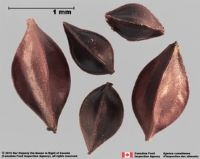 or thin-walled nutletnutlet:
or thin-walled nutletnutlet:
˜achene
enclosed within a persistent hard or fleshy calyxcalyx:
the outer whorl of the perianth; all the sepals of a flower , forming an anthocarpanthocarp:
, forming an anthocarpanthocarp:
simple or compound and including some tissue of non-ovarian origin (accessory tissue)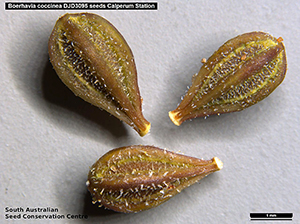 , except in Leucastereae (Andradea, Leucaster, Ramisia, Reichenbachia), 1.8–52 mm long, rarely to 100 mm long (Ceodes longirostris), usually elongated, ellipsoidalellipsoid:
, except in Leucastereae (Andradea, Leucaster, Ramisia, Reichenbachia), 1.8–52 mm long, rarely to 100 mm long (Ceodes longirostris), usually elongated, ellipsoidalellipsoid:
3D shape—elliptic
to clavateclavate:
3D shape—club-shaped, with attachment at or near narrow end (compare obclavate)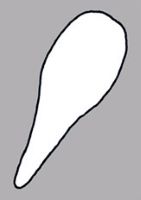 , tereteterete:
, tereteterete:
approximately circular in cross section; width and thickness approximately equal
 in transection, stylestyle:
in transection, stylestyle:
in a flower, the narrow and elongated part of the pistil between the stigma and the ovary; sometimes persisting in fruit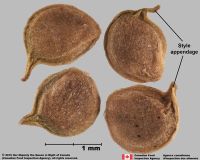 persistent, short beakedbeak:
persistent, short beakedbeak:
a usually firm, terminal appendage, sometimes tapered or not, margins longitudinally lobed, ribbedribbed:
or not, margins longitudinally lobed, ribbedribbed:
surface relief—wide, prominent, linear ridges that are generally rounded and longitudinally situated on the surface , or forming wings (2–5) (then fruit samara-like), with one seed. Anthocarpanthocarp:
, or forming wings (2–5) (then fruit samara-like), with one seed. Anthocarpanthocarp:
simple or compound and including some tissue of non-ovarian origin (accessory tissue) wall (or pericarppericarp:
wall (or pericarppericarp:
fruit wall or fruit coat
in Leucastereae) usually black or brown, dulldull:
reflecting only a low proportion of incident light, with no apparent sheen , leatheryleathery:
, leatheryleathery:
texture—moderately thick, tough, and very pliable
, woodywoody:
texture—consisting mainly of indurate lignified tissues, characteristic of or resembling wood
, corkycorky:
firm, relatively light, discontinuous but strongly cohesive, and resilient
, fleshy, or spongyspongy:
soft, light, discontinuous but cohesive, and somewhat resilient
, glabrousglabrous:
without hairs
or pubescentpubescent:
surface relief—bearing hairs
, often glandularglandular:
surface relief—covered with small, raised secretory glands, regular or irregularly shaped, translucent or opaque, and maybe distinctly colored (viscid glands or glandularglandular:
(viscid glands or glandularglandular:
surface relief—covered with small, raised secretory glands, regular or irregularly shaped, translucent or opaque, and maybe distinctly colored pubescence), smooth or deeply sulcatesulcate:
pubescence), smooth or deeply sulcatesulcate:
surface relief—having one or more elongate, relatively narrow and shallow depressions or grooves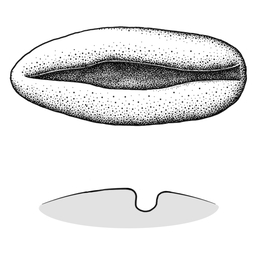 or groovedgrooved:
or groovedgrooved:
surface relief—linear depressions that may be single or form a series of grooves over the surface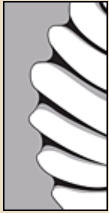 , wrinkledwrinkled:
, wrinkledwrinkled:
surface relief—shallow, irregular folds and furrows covering the surface; appearing overall though crumpled and then spread out , wartywarty:
, wartywarty:
surface relief—distinct, rounded projections that are large relative to the fruit size; tuberculate, verrucose , papillatepapillate:
, papillatepapillate:
surface relief—bearing minute, distinct, broad-based projections, tapering to a rounded apex , or spinose. In anthocarpsanthocarp:
, or spinose. In anthocarpsanthocarp:
simple or compound and including some tissue of non-ovarian origin (accessory tissue) , pericarppericarp:
, pericarppericarp:
fruit wall or fruit coat
is not visible. Fruits often mucilaginousmucilaginous:
resembling mucilage; moist and sticky
when wetted.
Seeds similar in size and shape to fruit. Seed coat if adnate to pericarppericarp:
fruit wall or fruit coat
, embryo slightly curvedcurved:
(of embryo) linear embryo is curved into an arch or horseshoe with the ends far apart or straight or if distinct from pericarppericarp:
or straight or if distinct from pericarppericarp:
fruit wall or fruit coat
, then with annularannular:
3D shape—forming a ring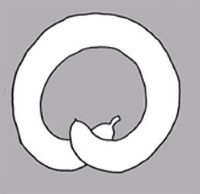 or horseshoe-shapedhorseshoe-shaped:
or horseshoe-shapedhorseshoe-shaped:
3D shape—relatively slender and strongly compressed, the whole strongly curved over its length in a plane perpendicular to the direction of compression and forming an incomplete circle, the ends somewhat straighter than the rest and parallel or nearly so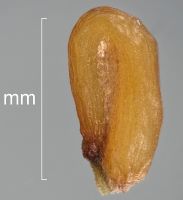 embryo. Seed coat brown, membranousmembranous:
embryo. Seed coat brown, membranousmembranous:
texture—extremely thin, pliable, and fairly tough
, smooth.
Embryo well developed, nearly filling or partially filling seed cavity, peripheralperipheral:
(of embryo) embryo is curved around the outer edge of the seed, near the seed coat
, conicalconical:
3D shape—cone-shaped, with the point of attachment at the broad end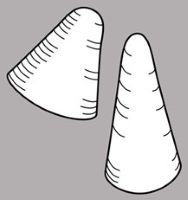 or foliatefoliate:
or foliatefoliate:
appearing leaf-like
, hooked, curvedcurved:
(of embryo) linear embryo is curved into an arch or horseshoe with the ends far apart , horseshoe-shapedhorseshoe-shaped:
, horseshoe-shapedhorseshoe-shaped:
3D shape—relatively slender and strongly compressed, the whole strongly curved over its length in a plane perpendicular to the direction of compression and forming an incomplete circle, the ends somewhat straighter than the rest and parallel or nearly so , annularannular:
, annularannular:
3D shape—forming a ring , or straight in Pisonieae, green.
, or straight in Pisonieae, green.
Perispermperisperm:
seed nutritive tissue comparable to the endosperm, but derived from the nucellus (maternal tissue)
usually scanty in ripe seeds.
| Fruit | |
| Type | acheneachene: a dry, indehiscent, one-seeded fruit, with seed attached to pericarp at a single point, derived from a single, superior, simple or compound, one-loculed ovary  , thin-walled nutletnutlet: , thin-walled nutletnutlet:˜achene enclosed within persistent hard, fleshy calyxcalyx: the outer whorl of the perianth; all the sepals of a flower  |
| Size range | 1.8–52 mm long, rarely to 100 mm long (Ceodes longirostris) |
| Shape(s) | globoseglobose: 3D shape—more or less spherical  , ellipsoidalellipsoid: , ellipsoidalellipsoid:3D shape—elliptic , fusiformfusiform: spindle-shaped; broadest at the middle and tapering at both ends 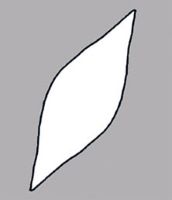 , turbinateturbinate: , turbinateturbinate:3D shape—broadly obovoid-obconic , clavateclavate: 3D shape—club-shaped, with attachment at or near narrow end (compare obclavate)  , obpyramidalobpyramidal: , obpyramidalobpyramidal:3D shape—pyramid-shaped, with point of attachment at or near narrow end (compare pyramidal) |
| Texture | leatheryleathery: texture—moderately thick, tough, and very pliable , woodywoody: texture—consisting mainly of indurate lignified tissues, characteristic of or resembling wood , corkycorky: firm, relatively light, discontinuous but strongly cohesive, and resilient , fleshy, spongyspongy: soft, light, discontinuous but cohesive, and somewhat resilient |
| Surface relief | often glandularglandular: surface relief—covered with small, raised secretory glands, regular or irregularly shaped, translucent or opaque, and maybe distinctly colored  , smooth or lobed, deeply sulcatesulcate: , smooth or lobed, deeply sulcatesulcate:surface relief—having one or more elongate, relatively narrow and shallow depressions or grooves  or groovedgrooved: or groovedgrooved:surface relief—linear depressions that may be single or form a series of grooves over the surface  , ribbedribbed: , ribbedribbed:surface relief—wide, prominent, linear ridges that are generally rounded and longitudinally situated on the surface  , winged, wrinkledwrinkled: , winged, wrinkledwrinkled:surface relief—shallow, irregular folds and furrows covering the surface; appearing overall though crumpled and then spread out  , wartywarty: , wartywarty:surface relief—distinct, rounded projections that are large relative to the fruit size; tuberculate, verrucose  , papillatepapillate: , papillatepapillate:surface relief—bearing minute, distinct, broad-based projections, tapering to a rounded apex  , spinose , spinose |
| Color(s) | black, gray, green, brown, reddish brown, yellow, orange-red, white |
| Unique features | Black, brown, or green, fleshy or hardened, viscid, elongate, 1-seeded fruits with grooves, ribs, or warts or with 2 to 5 longitudinallongitudinal: of or relating to length or the lengthwise dimension wings. |
| Other | |
| Embryo | well developed, nearly filling or partially filling seed cavity, peripheralperipheral: (of embryo) embryo is curved around the outer edge of the seed, near the seed coat or axileaxile: on or of the axis and centric (Pisonieae), conicalconical: 3D shape—cone-shaped, with the point of attachment at the broad end  or foliatefoliate: or foliatefoliate:appearing leaf-like , hooked, curvedcurved: (of embryo) linear embryo is curved into an arch or horseshoe with the ends far apart  , horseshoe-shapedhorseshoe-shaped: , horseshoe-shapedhorseshoe-shaped:3D shape—relatively slender and strongly compressed, the whole strongly curved over its length in a plane perpendicular to the direction of compression and forming an incomplete circle, the ends somewhat straighter than the rest and parallel or nearly so  , annularannular: , annularannular:3D shape—forming a ring  , or straight in Pisonieae , or straight in Pisonieae |
| Nutritive tissue | perispermperisperm: seed nutritive tissue comparable to the endosperm, but derived from the nucellus (maternal tissue) usually scanty in ripe seeds |
Tropical and subtropical regions
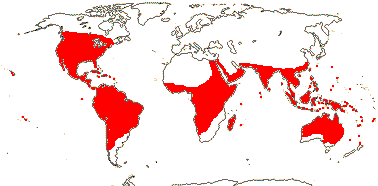
Distribution map courtesy of Angiosperm Phylogeny Website.
Acevedo-Rodríguez et al. 2015 onwardsAcevedo-Rodríguez et al. 2015 onwards:
Acevedo-Rodríguez P et al. 2015 onwards. Lianas and climbing plants of the Neotropics. URL: https://naturalhistory.si.edu/research/botany/research/lianas-and-climbing-plants-neotropics; Bingham et al. 2021+Bingham et al. 2021+:
Bingham MG, Willeman A, Wursten BT, Ballings P, and Hyde MA. 2021. Flora of Zambia. Accessed January 2021–April 2024. URL: https://www.zambiaflora.com; Bautista et al. 2022Bautista et al. 2022:
Bautista MAC, Zheng Y, Boufford DE, Hu Z, Deng Y, and Chen T. 2022. Phylogeny and taxonomic synopsis of the genus Bougainvillea (Nyctaginaceae). Plants 11: 1700. https://doi.org/10.3390/plants11131700; Bohlin 1988Bohlin 1988:
Bohlin JE. 1988. A monograph of the genus Colignonia (Nyctaginaceae). Nordic Journal of Botany 8: 231–252. https://doi.org/10.1111/j.1756-1051.1988.tb01716.x; Caraballo-Ortiz and Trejo-Torres 2017Caraballo-Ortiz and Trejo-Torres 2017:
Caraballo-Ortiz MA and Trejo-Torres JC. 2017. Two new endemic tree species from Puerto Rico: Pisonia horneae and Pisonia roqueae (Nyctaginaceae). PhytoKeys 86: 97–115. https://doi.org/10.3897/phytokeys.86.11249; da Silva Costa et al. 2023ada Silva Costa et al. 2023a:
da Silva Costa D, Dos Santos Batista CA, and Rossetto EFS. 2023. Two new species of Neea (Nyctaginaceae: Pisonieae) from humid forests in northern and northeastern Brazil. Kew Bull 78: 547–556. https://doi-org.offcampus.lib.washington.edu/10.1007/s12225-023-10126-8; da Silva Costa et al. 2023bda Silva Costa et al. 2023b:
da Silva Costa D, Sandoli Rossetto EF, and Terra Araujo MH. 2023. A new species of Neea (Pisonieae, Nyctaginaceae) from central and eastern Amazonia, Brazil, with a note on the typification of Neea ovalifolia. Brittonia 75: 307–317. https://doi-org.offcampus.lib.washington.edu/10.1007/s12228-023-09746-y; de Oliveira Chagas and da Costa-Lima 2020de Oliveira Chagas and da Costa-Lima 2020:
de Oliveira Chagas EC and da Costa-Lima JL. 2020. Re-Evaluation of some Brazilian Guapira (Nyctaginaceae) Names: A new species, nomenclatural changes and typifications. Systematic Botany 45: 173–182.; Douglas and Spellenberg 2010Douglas and Spellenberg 2010:
Douglas N and Spellenberg R. 2010. A new tribal classification of Nyctaginaceae. Taxon 59: 905–910.; Flora of North America Editorial Committee 1993+Flora of North America Editorial Committee 1993+:
Flora of North America Editorial Committee, eds. 1993+. Flora of North America North of Mexico [Online]. 22+ vols. Flora of North America Association, New York and Oxford. Accessed January-March 2024. URL: http://beta.floranorthamerica.org.; Friis et al. 2016Friis et al. 2016:
Friis I, Gilbert MG, Weber O, and Demissew S. 2016. Two distinctive new species of Commicarpus (Nyctaginaceae) from gypsum outcrops in eastern Ethiopia. Kew Bulletin 71(3). https://doi.org/10.1007%2FS12225-016-9648-3; Harriman 1999Harriman 1999:
Harriman NA. 1999. Synopsis of new world Commicarpus (Nyctaginaceae). SIDA 18: 679-684.; Kellogg 1988Kellogg 1988:
Kellogg EA. 1988. Nyctaginaceae. Flora of the Lesser Antilles, Leeward and Windward Islands 4: 173–186.; Kirkbride et al. 2006Kirkbride et al. 2006:
Kirkbride JH, Jr, Gunn CR, and Dallwitz MJ. 2006. Family guide for fruits and seeds, vers. 1.0. Accessed September 2020-January 2022. URL: https://nt.ars-grin.gov/seedsfruits/keys/frsdfam/index.cfm .; Kubitzki et al. 1990+Kubitzki et al. 1990+:
Kubitzki K et al., eds. 1990+. The families and genera of vascular plants. 7+ vols. Berlin etc.; Lentz and Dickau 2005Lentz and Dickau 2005:
Lentz DL and Dickau R. 2005. Seeds of Central America and Southern Mexico: The Economic Species. The New York Botanical Garden Press, New York. 298 pp.; Pignal et al. 2013Pignal et al. 2013:
Pignal M, de Oliveira Soares Filho A, and Romaniuc Neto S. 2013. Une nouvelle espèce de Neea Ruiz & Pav. (Nyctaginaceae) de la forêt atlantique de l'état de Bahia (Brésil). Adansonia 35: 19–31.; Prasanth Ravichandran et al. 2020Prasanth Ravichandran et al. 2020:
Prasanth Ravichandran A, Sardesai MM, and Yadav SR. 2020. Taxonomic and nomenclatural notes on Boerhavia (Nyctaginaceae) in India. Phytotaxa 455: 277–286. https://doi.org/10.11646/phytotaxa.455.4.5; Sandoli Rossetto et al. 2019Sandoli Rossetto et al. 2019:
Sandoli Rossetto EF, Oliveira Santos P, Silva Costa D, and Roberto Ferraz J. 2019. Neea itanhaensis (Nyctaginaceae, Pisonieae), a new species from São Paulo State, Brazil. Phytotaxa 415: 225–232. https://doi.org/10.11646/phytotaxa.415.4.7; Sandoli Rossetto and Caraballo-Ortiz 2020Sandoli Rossetto and Caraballo-Ortiz 2020:
Sandoli Rossetto EF and Caraballo-Ortiz MA. 2020. Splitting the Pisonia birdcatcher trees: re-establishment of Ceodes and Rockia (Nyctaginaceae, Pisonieae). PhytoKeys 152: 121–136. https://doi.org/10.3897/phytokeys.152.50611; Sandoli Rossetto and Roberto Ferraz 2020Sandoli Rossetto and Roberto Ferraz 2020:
Sandoli Rossetto EF and Roberto Ferraz J. 2020. Guapira siqueirae (Nyctaginaceae, Pisonieae), a new species from Espírito Santo State, Brazil. Phytotaxa 460: 143–148. https://doi.org/10.11646/phytotaxa.460.2.4; Sandoval-Ortega et al. 2020Sandoval-Ortega et al. 2020:
Sandoval-Ortega MH, Siqueiros-Delgado ME, Cerros-Tlatilpa R, and Ocampo G. 2020. La família Nyctaginaceae (Caryophyllales) en Aguascalientes, México. Acta Bot. Mexicana 127: 1–40; Struwig and Siebert 2013Struwig and Siebert 2013:
Struwig M and Siebert SJ. 2013. A taxonomic revision of Commicarpus (Nyctaginaceae) in southern Africa. South African Journal of Botany 84: 44–64. https://doi.org/10.1016/j.sajb.2012.09.009; Struwig et al. 2015Struwig et al. 2015:
Struwig M, Klaassen ES, and EG Kwembeya. 2015. Nyctaginaceae: A taxonomic treatment for the Flora of Namibia. Phytotaxa 238: 101–135. https://doi.org/10.11646/phytotaxa.238.2.1; Takhtajan 2009Takhtajan 2009:
Takhtajan A. 2009. Flowering plants: Second edition. Springer Nature, Switzerland. 871 pp.; Tillett 1967Tillett 1967:
Tillett SS. 1967. The maritime species of Abronia (Nyctaginaceae). Brittonia 19: 299–327. https://doi.org/10.2307/2805531; Tropicos.org 2021+Tropicos.org 2021+:
Tropicos.org. 2021+. Pakistan Plant Database. Missouri Botanical Garden. Accessed January 2021–April 2024. http://legacy.tropicos.org/Project/Pakistan; Tutin et al. 1964–1980Tutin et al. 1964–1980:
Tutin TG, Burges NA, Chater AO, Edmondson JR, Heywood VH, Moore DM, Valentine DH, Walters SM, and Webb DA (eds.) 1964–1980. Flora Europaea. 5 vols. Cambridge University Press, Cambridge UK. 2,524 pp.; Zhengyi et al. 2004+Zhengyi et al. 2004+:
Zhengyi W, Raven PH, and Deyuan H. 2004+. Flora of China [online]. 25 vols. Science Press, Beijing China & Missouri Botanical Garden, St. Louis USA. Accessed January–March 2024. http://flora.huh.harvard.edu/china/
*The number of genera and species is based on Christenhusz and Byng 2016Christenhusz and Byng 2016:
Christenhusz MJM and Byng JW. 2016. The number of known plant species in the world and its annual increase. Phytotaxa 261 (3): 201-217. https://doi.org/10.11646/phytotaxa.261.3.1, which may differ from the number of genera in GRIN-Global.